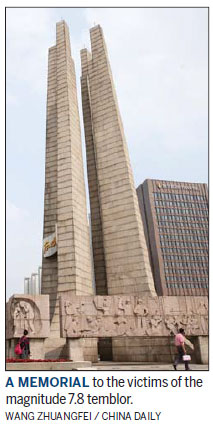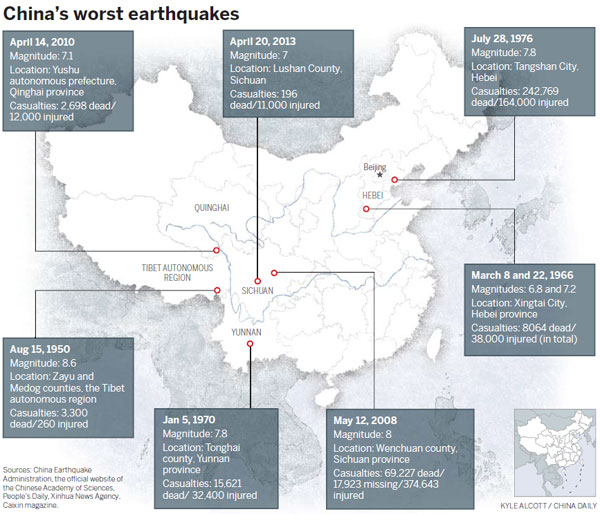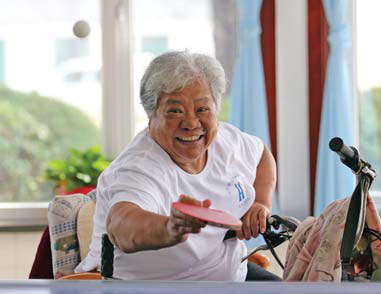Rebirth for city that died in one night
Updated: 2016-07-29 08:01
By Luo Wangshu and Zhang Yu(China Daily Europe)
|
|||||||||
Editor's note: July 28 marks the 40th anniversary of the Tangshan earthquake, which claimed more than 240,000 lives. China Daily talks with two people, brought together by the injuries they suffered, who have spent four decades rebuilding their lives.
Forty years ago, when Gao Zhihong had just graduated from college, she went home to visit her family. The joy of reunion didn't last long: 10 hours after the 25-year-old's arrival in Tangshan, Hebei province, the city was hit by a massive earthquake that caused more than 240,000 deaths.
That night, Gao's life was turned upside down.
|
Left: A man mourns his mother, a victim of the earthquake, at a memorial park in Tangshan, Hebei province. Right above: Tangshan lies in ruins after the devastating earthquake in 1976. Right below: An earthquake monument stands at the edge of a pond in the rebuilt Tangshan. Photos by Wang Zhuangfei / China Daily |
|
Although left paralyzed, Yang Yufang and his wife Gao Zhihong survived the Tangshan earthquake. Photos by Wang Zhuangfei / China Daily |
She had arrived in her hometown about 6 pm on July 27. "My whole family was so happy to see me. My sister and I planned to go shopping the next day," the 65-year-old recalls, her memories not dimmed by the intervening years.
The sisters' shopping expedition never materialized. About 4 am, a magnitude-7.8 earthquake hit Tangshan. Gao's father and sister were killed, while she and her mother were left paralyzed. Her two younger brothers were luckier, escaping with superficial injuries.
More than 240,000 of the city's 1 million urban inhabitants died in the quake, regarded as one of the most destructive in history. In addition, 160,000 people were seriously injured - more than 3,800 were paralyzed - and more than 4,200 children were orphaned.
|
Deng Yaping plays table tennis in her wheelchair in a local hospital. |
"My mother shook me awake when the quake occurred. My father ran toward the door, and I saw a concrete beam fall from the roof and hit him. I got up and ran to him, but I was hit by another falling beam. I was wedged between two of the beams, unable to move. I saw my father die," she recalls, her voice choked with emotion.
"It was so dark. I heard my brothers shouting my name, but I couldn't move. I was too weak and in too much pain to respond."
Gao was buried under the debris of the family home for about 10 hours until one of her brothers managed to free her.
Shortly after the quake, Gao was transferred to Xuzhou, Jiangsu province, and then Cangzhou in Hebei for treatment of her leg injuries. She did not return to Tangshan until 1980.
Gao's boyfriend broke off their relationship when he learned she would never walk again. "I was desperate. I cried myself to sleep every night for several years," she says.
At the time, she was unaware that her future husband was in the same situation. Yang Yufang, then 26, was also paralyzed in the quake, and was sent to larger cities for medical treatment. He found it hard to accept that his life had changed for good.
"When I returned to Tangshan, I put some clothes over my head, so I couldn't see the destruction in the city. Also, I was afraid to be seen; I was so ashamed of being crippled," says Yang, whose father and brother died in the quake.
Although it took a long time, he eventually was able to accept the reality of the situation. "What happened had happened. I couldn't rewrite history. There were only two paths in front of me to live or to die. I chose to live," he says.
"There was no use being angry or resentful. Once I had chosen to live, I had to face reality, to accept it and make the best of it."
Although Gao and Yang returned to Tangshan independently, they both moved into a clinic owned by the city, and met as patients there in 1981.
In the past four decades, more than 1,800 people paralyzed in the earthquake have been treated at the clinic, and 120 of them still live there.
In the 1980s, all college graduates were assigned jobs by the government, and in 1982, when Gao had recovered, she was given a job as a preschool teacher. Despite her background as an engineering major in college, she was gratified to be given a teaching job.
In those days, college graduates were seen as being especially gifted and were often known as "state treasures". Gao still keeps in touch with her college friends. "They are successful and making their contributions. They are leaders in factories, and some are even successful politicians. Sometimes I envy their success, but my life is peaceful and happy," she says.

She clearly remembers Aug 15, 1982, her first day at work: "I was so excited. I was no longer a loser. I had a job and I earned money. I love children. Sometimes when kids cried and would not leave their mom and dad, some parents put the child on my legs. Because I could not feel my legs, I never tired of the children sitting on them."
Once Gao had a job, she took her paralyzed mother under her wing. "At first, one of my brothers took care of my mother. He treated her very well, but I sometimes worried about him. Without a job and with a paralyzed mother to look after, what girl would marry him?"
To resolve the situation, Gao arranged for her mother to move into the clinic. She has taken care of her ever since.
Gao was so busy teaching her students and caring for her mother she failed to notice that Yang, her fellow patient, had fallen in love with her. It took three years, but in 1984, they married and moved into a 15-square-meter room provided by Gao's employer.
They still live there. Although they own only a queen-size bed, a wardrobe, two motorcycles adapted for the disabled and two wheelchairs, the tiny space is packed.
They would like to move to a bigger place, but money is an obstacle. "We can feed ourselves but can hardly afford a new house," Gao says.
Yang earns a living as an itinerant key maker, patrolling the streets with his tools. He also writes stories and poems. Sometimes the couple read Yang's poems at home, or share them with patients at the clinic, which they consider their second home, and on memorial occasions.
"I have experienced so much. I received help and love from others. Without their help, I would have died long ago. I have so much to say - that's why I started to write," says Yang, who also has written a novel and a play about the earthquake. Both will be published soon.
"After I became paralyzed, difficulty and I became twins," Yang says.
Gao echoes his sentiments: "Some of the things most people can do in five minutes take us a lot of effort to accomplish. Losing the ability to walk was devastating, but we are grateful because we are alive and we have each other."
Contact the writers through luowangshu@chinadaily.com.cn

City rises again like a phoenix from the ashes
Standing in the center of Tangshan, Hebei province, you can see rows of buildings stretching for miles, just like in many other modern cities in China.
There is no trace of the deadly earthquake that wiped out the city in 1976. Photos from the time show that nearly all the buildings collapsed. Some 95 percent of residential buildings and 90 percent of public buildings were destroyed.
In the four decades since the quake, the city has been completely reconstructed. Last year, Tangshan's GDP was 610 billion yuan ($91.6 billion; 82.7 billion euros). It ranks No 1 in Hebei and 25th in China - a far cry from the 2.16 billion yuan recorded in 1975.
As an industrial hub, Tangshan leads the country in heavy industries such as steel, coal, chemicals and equipment manufacturing, and its port is connected to 160 ports in more than 70 countries. The annual cargo capacity is 490 million metric tons, making it the sixth-largest port in China.
One of the city's goals is for the port to be involved in the national Belt and Road Initiative, which aims to promote infrastructure investment and trade links between Asia, Europe and elsewhere. The city hopes to become a hub connecting countries across northeastern Asia.
After 1976, the city adopted an alternative name, Phoenix city, after the legendary bird that was reborn in the flames, just as the new Tangshan was born from the disaster of the earthquake.
China Daily
(China Daily European Weekly 07/29/2016 page1)
Today's Top News
Obama, Merkel stress anti-terror cooperation
Downing Street cat fight: Larry vs Palmerston
No explosion, no injury report in Germany: Police
Geneva airport tightens security after French tipoff
Bill Clinton portrays Hillary as 'change-maker'
Priest, 84, killed in France, attack claimed by IS
Knife attacker in Japan kills 19 at disabled center
Michelle Obama rocks Democratic convention
Hot Topics
Lunar probe , China growth forecasts, Emission rules get tougher, China seen through 'colored lens', International board,
Editor's Picks

|

|

|

|

|

|










